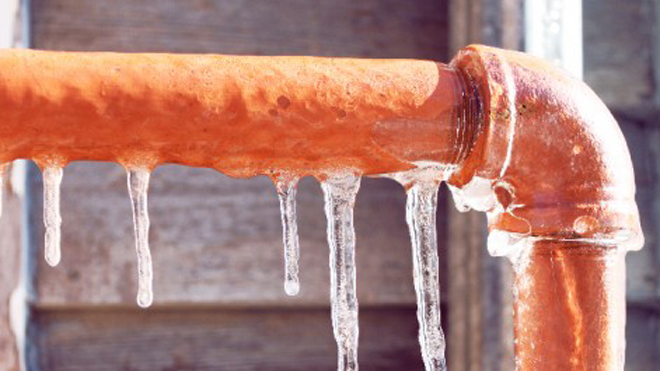How to Avoid Frozen Pipes in Cold Weather: Professional Advice
How to Avoid Frozen Pipes in Cold Weather: Professional Advice
Blog Article
We have discovered the article relating to Prevent Frozen Pipes directly below on the web and accepted it made perfect sense to quickly share it with you over here.

Cold weather can ruin your plumbing, especially by freezing pipelines. Here's just how to avoid it from taking place and what to do if it does.
Intro
As temperature levels decline, the risk of icy pipes boosts, potentially bring about costly fixings and water damage. Comprehending how to prevent frozen pipelines is crucial for homeowners in chilly climates.
Prevention Tips
Insulating susceptible pipelines
Cover pipelines in insulation sleeves or utilize heat tape to shield them from freezing temperature levels. Concentrate on pipes in unheated or external locations of the home.
Heating methods
Maintain interior rooms appropriately heated up, particularly locations with pipes. Open cabinet doors to enable warm air to flow around pipelines under sinks.
How to determine icy pipes
Look for decreased water circulation from taps, unusual odors or noises from pipelines, and visible frost on subjected pipes.
Long-Term Solutions
Structural modifications
Take into consideration rerouting pipelines away from outside wall surfaces or unheated areas. Add added insulation to attic rooms, cellars, and crawl spaces.
Upgrading insulation
Purchase high-quality insulation for pipelines, attic rooms, and walls. Proper insulation aids keep constant temperatures and reduces the threat of frozen pipelines.
Safeguarding Outdoor Plumbing
Yard hoses and outdoor taps
Disconnect and drain garden hoses before winter months. Set up frost-proof spigots or cover outdoor taps with shielded caps.
Recognizing Frozen Pipelines
What creates pipes to freeze?
Pipelines freeze when subjected to temperature levels listed below 32 ° F (0 ° C) for expanded durations. As water inside the pipes freezes, it broadens, taxing the pipeline wall surfaces and possibly creating them to break.
Risks and damages
Icy pipelines can bring about supply of water disturbances, residential or commercial property damages, and costly repairs. Ruptured pipes can flood homes and cause substantial architectural damages.
Indicators of Frozen Pipes
Determining frozen pipes early can stop them from rupturing.
What to Do If Your Pipelines Freeze
Immediate actions to take
If you think icy pipelines, keep taps open up to alleviate stress as the ice thaws. Utilize a hairdryer or towels soaked in hot water to thaw pipelines slowly.
Final thought
Stopping icy pipelines requires proactive steps and fast reactions. By understanding the causes, signs, and safety nets, house owners can secure their pipes during cold weather.
5 Ways to Prevent Frozen Pipes
Drain Outdoor Faucets and Disconnect Hoses
First, close the shut-off valve that controls the flow of water in the pipe to your outdoor faucet. Then, head outside to disconnect and drain your hose and open the outdoor faucet to allow the water to completely drain out of the line. Turn off the faucet when done. Finally, head back to the shut-off valve and drain the remaining water inside the pipe into a bucket or container. Additionally, if you have a home irrigation system, you should consider hiring an expert to clear the system of water each year.
Insulate Pipes
One of the best and most cost-effective methods for preventing frozen water pipes is to wrap your pipes with insulation. This is especially important for areas in your home that aren’t exposed to heat, such as an attic. We suggest using foam sleeves, which can typically be found at your local hardware store.
Keep Heat Running at 65
Your pipes are located inside your walls, and the temperature there is much colder than the rest of the house. To prevent your pipes from freezing, The Insurance Information Institute suggests that you keep your home heated to at least 65 degrees, even when traveling. You may want to invest in smart devices that can keep an eye on the temperature in your home while you’re away.
Leave Water Dripping
Moving water — even a small trickle — can prevent ice from forming inside your pipes. When freezing temps are imminent, start a drip of water from all faucets that serve exposed pipes. Leaving a few faucets running will also help relieve pressure inside the pipes and help prevent a rupture if the water inside freezes.
Open Cupboard Doors
Warm your kitchen and bathroom pipes by opening cupboards and vanities. You should also leave your interior doors ajar to help warm air circulate evenly throughout your home.

I am very enthusiastic about How to prepare your home plumbing for winter weather and I am praying you enjoyed the new blog post. Do you know about somebody else who is enthusiastic about Helpful Tips to Prevent Frozen Pipes this Winter? Take a moment to share it. I truly appreciate your readership.
Browse Website Report this page